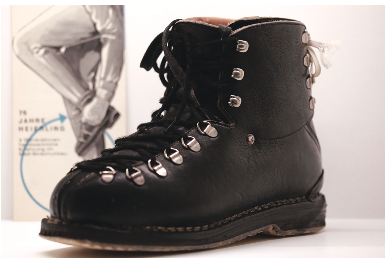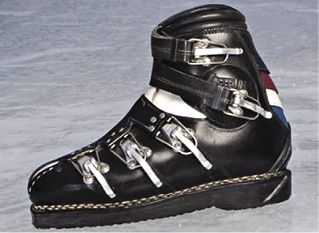

At one time, Heierling was among the most famous names in skiing. In the postwar years, the Swiss company’s handmade leather boots equipped an entire generation of racing champions.
Beginning in 1885, cobbler Franz Heierling copied the Laupar shoe brought to Davos by Norwegian ski instructors. His son Hans introduced custom-made ski boots for jumpers, with a high supportive shaft. With the introduction of Guido Reuge’s Kandahar binding and the evolution of alpine technique in the 1930s, Heierling developed higher heels and longer lacing, in custom-fitted boots like the Allais Special II, used by Emile Allais, Walter Prager and Jack Ettinger, among other champions.

1964, when Billy Kidd and Jimmie
Heuga won their Olympic medals.
Beginning with the 1948 Olympics in St. Moritz, and through to the introduction of plastic boots after the 1964 games in Innsbruck, Heierling’s double boots, with brass-reinforced soles, equipped French, Swiss and American medalists. The Davos shop was able to produce up to 3,000 custom-fitted boots annually, mostly for skiers who had visited the shop at one time and had their feet measured. Heierling kept those measurements on file and could make replacement boots years later. With the introduction of injection-molded outsoles, the company was able to export about 15,000 pairs of mid-priced, mass-produced (non-custom) boots each year.
After 1972, to keep up with the boom in plastic boots, Heierling needed to collaborate with partner factories that could tool up for rapid mass production. Weinmann, the manufacturer of bicycle components, produced a cable-closure Heierling boot. Manufacturing moved to Slovenia, Italy and Germany. The brand name was licensed to Rhode Island retailer Harold Jacober. For a couple of decades Jacober sold it into ski shops across North America. At home in Davos, the brothers Thomas and Hans-Martin Heierling continued to operate a custom-fitting boot shop catering first to racers, then to the public, and by 1983 were also able to sell 90,000 pairs annually of Heierling-brand mass-produced ski boots into the wholesale trade. Even so, the highly competitive export environment forced the closure of many small boot factories, and Heierling shipped its last Italian-made boot in 1997.
The family returned to its roots in custom fitting. In 2000, Heierling’s Sportschuh-Fitting-Center became the Heierling Salomon Racing Center. Among others, Lindsey Vonn, Bode Miller and Didier Cuche got their boots fitted there. In 2005 Atomic licensed Heierling’s patented I-Flex technology; based on that, Hans-Martin, with Sven Coomer, developed Atomic’s very successful Hawx series boots. In 2013, Hans-Martin launched the Swiss-made Heierling H1, made of a temperature-tolerant material to maintain consistent flex down to -20° Celsius. The limited-production boot is available in Switzerland, Austria, France and the United States.
